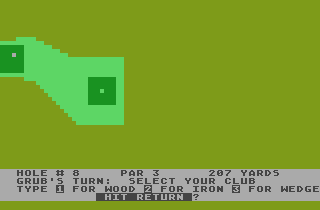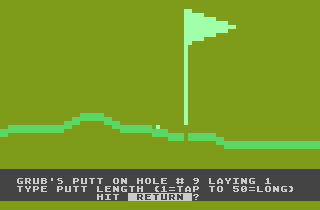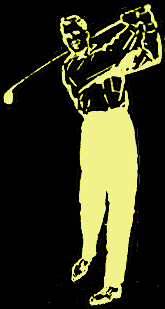 |
SUNDAY GOLF
(1980) |

REVIEW
by AtariGrub
![]()
In the world of sport, Golf can be one of the most relaxing of pastimes, as you stroll through the countryside trying to club your ball into each hole in the least number of turns. For those unfamiliar with the intricacies of the game, then scroll down for a Short Guide to Golf.
 Like
perhaps many sport simulations, a lot of players will agree that most of the
skill and fun is sometimes lost in translation to a computerised format. In
some cases these differences make the computer version unrecognisable from the
real-life activity it is trying to emulate. For me, golf is the chance to see
some locked-away countryside, taking in the fresh air and enjoying the least
energetic of outdoor sports. In this case, Sunday Golf is perhaps one of the
poorest game translations that I have ever played.
Like
perhaps many sport simulations, a lot of players will agree that most of the
skill and fun is sometimes lost in translation to a computerised format. In
some cases these differences make the computer version unrecognisable from the
real-life activity it is trying to emulate. For me, golf is the chance to see
some locked-away countryside, taking in the fresh air and enjoying the least
energetic of outdoor sports. In this case, Sunday Golf is perhaps one of the
poorest game translations that I have ever played.
Released in 1980 it was possibly one of the first Golf games on the Atari 8-bit, but it is now hard for me not to contrast it to the excellent Tournament Leader Board (1986 - Access Software). For a start, any game written in BASIC always has its drawbacks, but the main problem for me is that this game is simply played by entering numbers with the keyboard.
After the title page (confusingly titled Pro Tour Golf and not Sunday Golf) you are presented with a shot direction screen, a club list with approximate yardage for each club and a choice of long or short course game. Both game types consist of nine randomly drawn courses, but the long game features a greater length from tee to hole. Up to four players can compete and as each turn begins you are given a choice of using a wood, an iron or wedge from your bag.
 Courses
are presented to you as a birds-eye view, drawn in crude graphics on the screen,
with an information bar along the bottom detailing the current course (hole
number), par for that course and the distance in yards to the green. Once you've
selected your club you must decide on a direction using the numbers 0 to 39.
0 is north, 10 is east, 20 is south and 30 west. So if you want your ball to
travel diagonally to the bottom right of your current position on the screen
you would type 15. The distance your ball then travels is randomised around
the approximate yardage that has been given for each club (shown after the main
title screen).
Courses
are presented to you as a birds-eye view, drawn in crude graphics on the screen,
with an information bar along the bottom detailing the current course (hole
number), par for that course and the distance in yards to the green. Once you've
selected your club you must decide on a direction using the numbers 0 to 39.
0 is north, 10 is east, 20 is south and 30 west. So if you want your ball to
travel diagonally to the bottom right of your current position on the screen
you would type 15. The distance your ball then travels is randomised around
the approximate yardage that has been given for each club (shown after the main
title screen).
Once you finally reach the green the screen changes to a side view of the terrain, your ball and a flag hovering over the hole. From here you select a number from 1 (slight tap of the putter) to 50 (hard tap) in order to coax your ball to its final destination. This can be the most frustrating part of the game as entering 10, for example, when the hole is 9 pixels away means the ball would roll straight over it and stop 1 pixel away!
Amusingly, the manual
for this game suggests you may even give up real golf for a chance to play this
game with its nine colours and sound! The fact is, sound is minimal and other
factors such as wind and terrain height are (luckily?) missing from this tedious
game. Trust me, there are better things to do on a Sunday than play this game!
|
"FORE!!"
(2/10) |
![]()
GAME TIPS
|
SUNDAY
GOLF - SHOT DIRECTIONS
|
|
North-West
35 |
North |
North-East 5 |
|
West
- 30
|
 |
10 - East |
|
25
South-West |
20
South |
15 |
|
CLUB
|
APPROXIMATE
YARDAGE
|
|
1
WOOD
|
250
yards
|
|
2 WOOD
|
230 yards
|
|
3 WOOD
|
210 yards
|
|
4 WOOD
|
190 yards
|
|
1 IRON
|
175 yards
|
|
2 IRON
|
160 yards
|
|
3 IRON
|
145 yards
|
|
4 IRON
|
130 yards
|
|
5 IRON
|
115 yards
|
|
6 IRON
|
100 yards
|
|
7 IRON
|
85 yards
|
|
8 IRON
|
70 yards
|
|
9 IRON
|
55 yards
|
|
WEDGE
|
40 yards
|
![]()
Short Guide To . . . GOLF
 Golf
is an outdoor sport, originally invented by the Scottish in the mid 15th Century.
Each game involves using a set of clubs to send a golf ball from the teeing
off area and into a hole on the putting green in the least number of strokes.
The courses are all given ratings for example a 3 par or 4 par. This number
denotes the number of strokes it should take to get the ball into the hole on
the green.
Golf
is an outdoor sport, originally invented by the Scottish in the mid 15th Century.
Each game involves using a set of clubs to send a golf ball from the teeing
off area and into a hole on the putting green in the least number of strokes.
The courses are all given ratings for example a 3 par or 4 par. This number
denotes the number of strokes it should take to get the ball into the hole on
the green.
Golfers
carry a set of clubs, each of which can hit the ball a particular distance (taking
in wind factor, angle of swing, force used, etc). Wooden headed clubs are used
first as they can take the ball the farthest. This is followed by the use of
iron headed clubs from the long range "1 iron" down to a short hurling
"9 iron". A pitching wedge is used to get the ball out of rough areas
and finally a putting wedge used to gently coax your ball into the hole on the
finely mown green. Various hazards such as sand pits, rough areas, water and
trees add some element of strategy to the game, with the player having to decide
to either hit the ball over or around problem areas. Scores of each course are
totted up at the end and the player with the lowest score is the winner.
![]()

About.com
(Golf History - Frequently Asked Questions)
golf.about.com/od/historyofgolf/a/faq_golfhistory.htm
Pinemeadow Golf
(The basics of golf clubs including the best clubs to use and golf club terminology
definitions)
www.pinemeadowgolf.com/clubs101_1.html
The Golf Channel
(Latest Golf news, plus photos and interviews with all the golf stars)
www.thegolfchannel.com/
Golf Today
(Find information and news on all the lastest golf tours)
www.golftoday.co.uk/